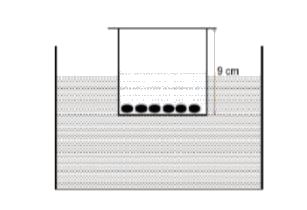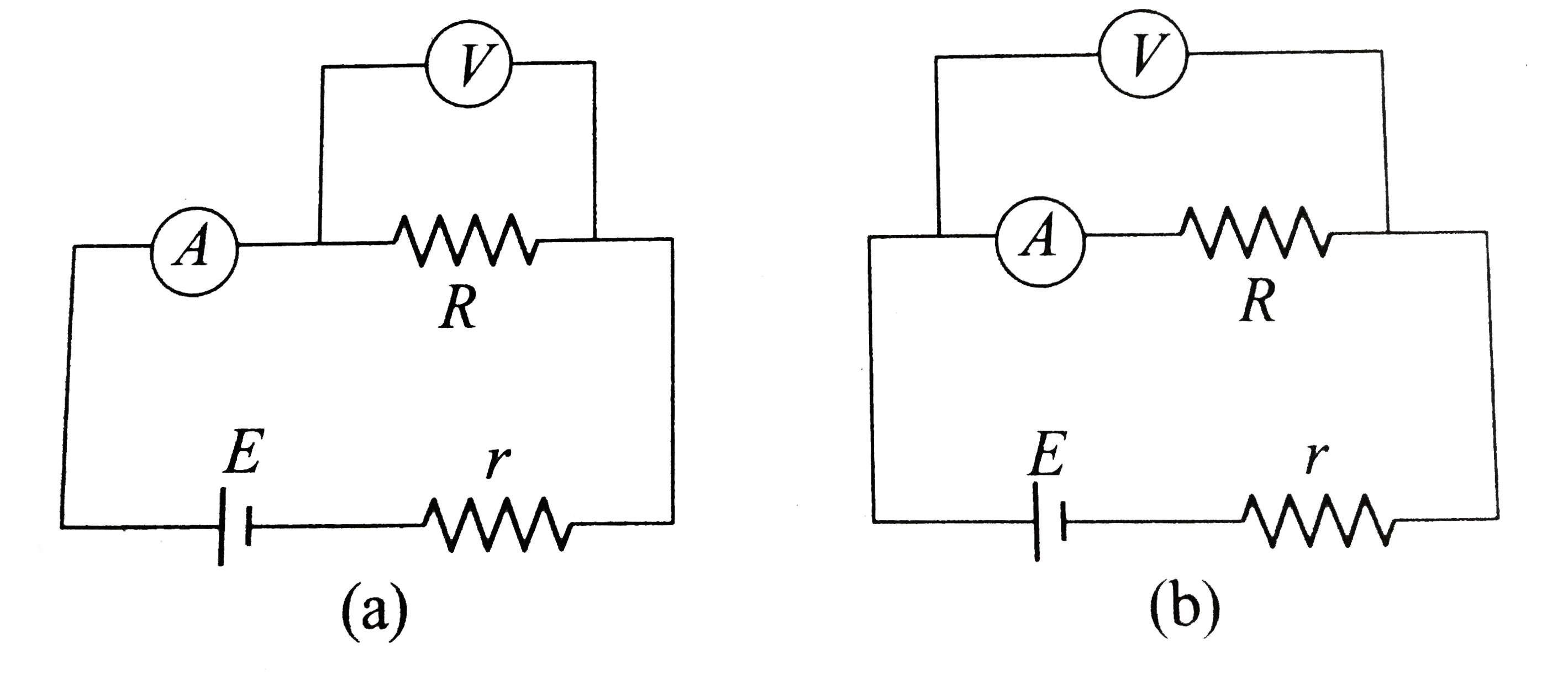Consider the two circuits P and Q, shown below, which are used 20 measure the unknown resistance R.

In each case, the resistance is estimated by using Ohm's law Rest=V/I, Where V and I are the readings of the voltmeter and the ammeter respectively. The meter resistances, Rv and RA are such that RA<<R<<Rv. The internal resistance of the battery may be ignored. The absolute error in the estimate of the resistance is denoted by δR=|R=Rest|.
Step by step video & image solution for Consider the two circuits P and Q, shown below, which are used 20 measure the unknown resistance R. In each case, the resistance is estimated by using Ohm's law R_("est" = V // I, Where V and I are the readings of the voltmeter and the ammeter respectively. The meter resistances, R_(v) and R_(A) are such that R_(A) ltlt R ltlt R_(v). The internal resistance of the battery may be ignored. The absolute error in the estimate of the resistance is denoted by deltaR = |R = R_("est")|. by Physics experts to help you in doubts & scoring excellent marks in Class 12 exams.
Topper's Solved these Questions
Similar Questions
A wide bottom cylindrical massless plastic container of height 9 cm has 40 identical coins inside it and is floating on water with 3 cm inside the water. If we start putting more of such coins on its lid. It is observed that after N coins are put, its equilibrium changes from stable to unstable. Equilibrium in floating is stable if the geometric center of the submerged portion is above the center of mass of the object) The value of N is closed to
 06:11View Solution
06:11View SolutionThe value of resistance of an unknown resistor is calculated using the formula R = V//I where V and I are the readings of the voltmeter and the ammeter, respectivley. Consider the circuits below. The internal resistances of the voltmeter and the ammeter (R_V and R_G, respectively) are finite and nonzero. , Let R_(A) and R_(B) be the calculated values in the two cases A and B , respectively. If the resistance of voltmeter is R_(V) = 1k Omega and the percentage error in the measurement of R (the value of R is nearly 10 Omega )is
03:27View SolutionIn the, Ohm's law experiment to find resistance of unknown resistor R , following two arrangement ( a ) and ( b ) are possible. The resistance measured is given by R_(measured)=(V)/(i) V = voltage reading of voltmeter, i= current Reading of ammeter. But unfortunately the ammeters and voltmeter used are not ideal, but having resistance R_(A) and R_(V) respectively. For arrangement ( s ), the measured resistance is
03:02View SolutionIn the, Ohm's law experiment to find resistance of unknown resistor R , following two arrangement ( a ) and ( b ) are possible. The resistance measured is given by R_(measured)=(V)/(i) V = voltage reading of voltmeter, i= current Reading of ammeter. But unfortunately the ammeters and voltmeter used are not ideal, but having resistance R_(A) and R_(V) respectively. For arrangement ( b ), the measured resistance is
View SolutionIn the, Ohm's law experiment to find resistance of unknown resistor R , following two arrangement ( a ) and ( b ) are possible. The resistance measured is given by R_(measured)=(V)/(i) V = voltage reading of voltmeter, i= current Reading of ammeter. But unfortunately the ammeters and voltmeter used are not ideal, but having resistance R_(A) and R_(V) respectively. You are given two resistor X and Y . Whose resistance is to be determined , using an ammeter of R_(A)=0.5Omega and a voltmeter of R_(V)=20 KOmega . It is known that X is in range of a few Ohm and Y is in range of several kilo ohm. Which of the circuit is preferable to measure X and Y -Resistor Circute
02:03View SolutionIf G,rA and rV denote the internal resistances of a galvanometer, an ammeter and a voltmeter among the following the correct relationship is
02:31View SolutionIn the, Ohm's law experiment ot find resistance of unknown resistor R, the arrangement is as shown. The resistance measured is given by R_("measured")=(V)/(i)V= voltage reading of voltmeter. i=current reading of ammeter. The ammeters and the voltmeter used are not ideal, and have resistance R_(A) and R_(V) respectively. For arrangement shown, the meausred resistance is
View SolutionA voltmeter of resistance R_(V) and an ammeter of resistance R_(A) are connected as shown in an attempt to measure the resistance R . The measured value of the resistance is R_(M) = (V)/(I_(0)) where V is reading of voltmeter and I_(0) is reading of the ammeter. find the true value of the resistance in terms of R_(M), R_(V) and R_(A) .
03:48View SolutionTwo cells of same emf epsilon , but different internal resistances r_(1) " and " r_(2) are connected to an external resistance R, as shown. The voltmeter V reads zero. Find R in terms of r_(1) " and " r_(2) , and the voltage across the cell of internal resistance r_(2) .
View SolutionIn the Ohm'slaw experiment to find resistance of unknown resistor R following arrangements (a) and (b) are possible The resistance measured is given by R_(measured)=(V)/(i) V = voltage reading of voltmeter I = current Reading of ammeter But unfortunately the ammeters and voltmeter used are not ideal but having resistance R_(A) and R_(v) respect tively Yor are given two unknown resistors X and Y These resistances are to be determind using an ammeter of R_(A) = 0.5Omega and a voltmeter of R_(v) = 20kOmega It is known that X is in range of a few ohms and Y is in the range of several kilo ohm's Which circuit is perferable to measure X and Y {:("Resistor",Circuit),(x,(a)),(y,(b)):} .
01:37View SolutionLet V and I be the readings of the voltmeter and the ammeter respectively as shown in the figure. Let R_(V) " and "R_(A) be their corresponding resistancce Therefore,
11:04View SolutionA voltmeter of resistance R_(V) and an ammeter of resistance R_(A) are connected in series across a battery of emf E and of negligible internal resistance . When a resistance R is connected in parallel to volmeter , reading of ammeter increases to three times while that of volmeter reduces to one - third. Calculate R_(A)andR_(V) in terms of R.
03:46View SolutionThe value of resistance of an unknown resistor is calculated using the formula R=V/I where V and I are the readings of the voltmeter and the ammeter, respectivley. Consider the circuits below. The internal resistances of the voltmeter and the ammeter (RVandRG,respectively) are finite and nonzero.
 ,
,
Let RAandRB be the calculated values in the two cases A and B , respectively.
If the resistance of voltmeter is RV=1kΩ and the percentage error in the measurement of R (the value of R is nearly 10Ω)isView SolutionTheemfofcellis 9V andits intemal resistance is unknown. The resistances of the meters are also unknown. When the switch S is closed, the measured current increases to twice of previous value and the reading of voltmeter decreases to half of the original value. The ratio RVR, where RV is the resistance of the voltmeter, is
'(##CEN_KSR_PHY_JEE_CO20_E01_015_Q10##)'04:14View SolutionIn the, Ohm's law experiment to find resistance of unknown resistor R, following two arrangement (a) and (b) are possible.

The resistance measured is given by
Rmeasured=Vi
V= voltage reading of voltmeter, i= current Reading of ammeter.
But unfortunately the ammeters and voltmeter used are not ideal, but having resistance RA and RV respectively.
For arrangement (b), the measured resistance is03:12View Solution

